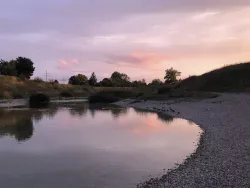Ultimate Hiking Packing List - Travel Essentials

Why should you be prepared
Embarking on a hike is like stepping into a world of wonder, where nature’s beauty and challenges converge. But here’s the catch: What you pack can make or break your experience.
Imagine this: You’re deep in the wilderness, surrounded by towering trees, and you suddenly realize you’ve forgotten essential gear. Panic sets in, and your serene adventure spirals into a survival challenge. This is the reality of hiking unprepared.
In this guide, we’re unlocking the key to hiking success. Discover must-have essentials, life-saving tools, and tips from seasoned hikers who’ve conquered the wildest terrains on Earth.
From the mystical trails of the Appalachian Mountains to the arid beauty of the Grand Canyon, we’ll ensure you’re equipped with the know-how and gear to tackle any destination with confidence. Whether you’re planning a day hike or an epic backpacking journey, it’s time to learn what to bring on a hike for a safe and thrilling adventure.
Pro tip
Use dry bags to organize and waterproof your gear and clothing inside your backpack. This not only keeps your items organized and easily accessible but also ensures they stay dry in case of unexpected rain or water crossings
Top Packtips for Travel!
Packing List for a Hike
Clothes
- Hiking Boots
Buy
- Hiking Socks
- Hiking Jacket
Buy
- Hiking Pants
Buy
- Fitness Shirt
- Scarf
- Beanie
- Gloves
- Heavy Coat
Buy
- Thermal underwear
Buy
- Hat
Hygiene
Accessories
- Knife
Buy
- Insect Repellent
- Headlamp
- Portable Lantern
- Camping Stove
- Sleeping Bag
Buy
- Tent
Items not advised for a hike
While it’s important to be prepared when embracing a hike, it’s also to know which items should be left at home, as they could be damaged or ruin the hike experience. We have sammled a list with all the items you should not bring to a hike.
- Formal shoes
- Formal clothing
- Valuable jewelry
- Loud electronics
- Strong perfumes
- Bulky backpacks
- Luxury items
- Excessive waste
- Impractical camping gear
- Messy food containers
- Disposable bottles (Use reusable bottles instead)
- Heavy makeup

Items for Kids
When hiking with kids, it’s important to ensure their comfort, safety, and entertainment. Here are some specific items you should consider bringing for children on a family hike:
- Child Carrier Backpack: If your child is too young to walk long distances, a child carrier backpack allows you to carry them comfortably on your back.
- Child-Sized Backpack: If your child is old enough to walk, consider giving them a small backpack to carry their own snacks, water, and a small toy.
- Extra Clothing: Kids can get messy and may need a change of clothes. Pack spare clothing appropriate for the weather.
- Snacks: Bring a variety of kid-friendly snacks to keep their energy up, such as trail mix, granola bars, fruit, and crackers.
- Water and Water Bottles: Make sure your child stays hydrated with their own water bottle. Consider a spill-proof bottle for younger children.
- Child Safe Bug Repellent: If you’re hiking in an area with bugs, child-safe bug repellent can help keep them comfortable.
- Navigation and Exploration Tools: A small magnifying glass, binoculars, or a simple compass can make the hike more engaging for kids.
- Map and Educational Materials: Depending on the age of your child, you can bring a trail map or educational materials about the flora and fauna you might encounter on the hike.
- Comfort Items: If your child has a comfort item like a stuffed animal or blanket, it might be helpful to bring it along for reassurance.
- Trash Bags: Encourage responsible hiking by teaching kids to pack out their trash and any litter they might find.
- Entertainment: Small toys, books, or nature-themed games can help keep children engaged during breaks.
Adjust the items based on the age and needs of your child. Safety, comfort, and keeping them engaged are the key considerations when hiking with kids.
Packing Techniques for a Hike
Pack Smart
When it comes to packing for a hike, it’s essential to pack smart and efficiently to ensure you have everything you need without overloading your backpack. Here are some tips to help you organize and optimize space in your backpack:
-
Prioritize Essentials: Start by making a list of essential items you’ll need for your hike. Focus on the basics like clothing, food, water, and safety gear. Avoid packing unnecessary items that can weigh you down.
-
Use Packing Cubes or Compression Sacks: Packing cubes or compression sacks can help you compartmentalize your gear and reduce wasted space. Roll or fold clothing items tightly and place them in these cubes to maximize space.
-
Layer Strategically: Place heavier and denser items, like your tent or cookware, at the bottom of your backpack. Lighter and frequently needed items should go on top for easy access.
-
Consider Multi-Use Items: Opt for gear that serves multiple purposes. For example, a bandana can double as a headband, towel, or even a makeshift sling.
-
Streamline Your Toiletries: Use travel-sized containers for toiletries and only bring the essentials. Consider biodegradable soap to minimize your impact on the environment.
-
Pack Food Efficiently: Use resealable bags for snacks and meals, removing excess packaging. This not only saves space but reduces waste.
-
Limit Extra Clothing: Avoid packing excessive clothing options. Stick to the essentials for the anticipated weather conditions, and remember that layering can help regulate temperature.
Leave No Trace on the Trail
As responsible hikers, it’s crucial to follow the principles of Leave No Trace ethics to minimize our impact on the environment and preserve the natural beauty of hiking trails. Here’s how you can practice Leave No Trace:
-
Plan Ahead and Prepare: Do your research before your hike. Understand the regulations and guidelines for the area you plan to visit. Check for fire bans, camping restrictions, and any specific rules.
-
Stay on Designated Trails: Stick to established hiking trails to avoid trampling on fragile ecosystems. Avoid creating new paths or shortcuts.
-
Pack Out All Waste: This includes all trash, leftover food, and even biodegradable items like fruit peels. Use proper waste disposal methods, and if there are no facilities, carry everything out with you.
-
Minimize Campfire Impact: If fires are allowed and necessary, use established fire rings or stoves. Keep fires small, and burn only small sticks and twigs. Put out fires completely when done.
-
Respect Wildlife: Observe animals from a distance and avoid feeding them. Feeding wildlife disrupts their natural behaviors and can harm both animals and humans.
-
Be Considerate of Other Hikers: Keep noise levels down, yield the trail to others, and maintain a friendly and respectful attitude towards fellow hikers.
-
Leave What You Find: Don’t pick flowers or remove rocks, plants, or historical artifacts. Leave natural and cultural features as you found them.
By adhering to these Leave No Trace principles, you can help protect the environment and ensure that future generations can enjoy the beauty of the wilderness as much as you do.
What should you know before going to a Hike
How much weight should you carry on a hike?
A good target for base weight is around 10-20% of your body weight. So, if you weigh 150 pounds, your base weight should ideally be between 15 and 30 pounds.
How should you prepare for a 3 day hike
| Day Hike | 3-Day Hike | |
|---|---|---|
| Pack Size | 10L | 30L |
| Duration | Few hours to a full day | Multiple days with overnight camping |
| Distance | Shorter, typically up to 15-20 miles | Longer, often 20-40+ miles |
| Clothing | Lightweight for a day, dress for weather | Additional clothing, layers, and spare clothes for varying weather conditions |
| Camping Gear | None (no overnight stay) | Camping gear required, including a tent, sleeping bag, sleeping pad, and cooking equipment |
| Food and Water | Enough for the day | Meals for multiple days, possibly with dehydrated or freeze-dried foods and water filtration |
| Navigation | Basic navigation tools like map, compass, or GPS | Detailed navigation tools and maps for multi-day routes |
| Emergency Gear | Basic first aid, headlamp, whistle | More comprehensive first aid, emergency shelter, fire-starting kit, and multi-tool |
| Permits/Regulations | Minimal considerations, if any | May require permits and adherence to camping regulations |
| Leave No Trace | Basic principles to minimize impact | Comprehensive Leave No Trace practices to minimize environmental impact during extended stays |


